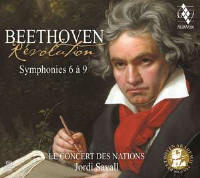Texte paru dans: / Appeared in: |
|
 Recording of the month
Recording of the month |
Outil de traduction |
|
Reviewer: Mark Pullinger Chapeau to Jordi Savall and Le Concert des Nations. The pandemic delayed the completion of their Beethoven symphony cycle but they came out fighting. As soon as conditions in Spain permitted, the orchestra – 35 players from Le Concert des Nations, including some long-serving members, plus around 20 young players from across Europe – reconvened their ‘Akademies’, intense six-day periods of rehearsals, concerts and recording sessions, nailing the Sixth and Seventh in July 2020. The Eighth was taped in Wrocław in October 2020 but the Ninth there was scuppered when four members of the choir tested positive for Covid on the very day they were due to record the final movement. Several other performers, including Savall himself, then caught it, which forced the cancellation of the rest of their scheduled European tour (‘an artistic and financial catastrophe’, the conductor writes). Undeterred, they reattempted the Ninth again in autumn 2021, enabling the cycle’s completion. As Savall argues in his eight-page booklet note – with, one senses, a wry smile – as Beethoven was born in December 1770, his 250th anniversary must logically run from December 2020 until December 2021 … so they did complete their project in time. It was titled ‘Beethoven Révolution’, but how revolutionary do these recordings actually sound, given the period-instrument charge into performing Beethoven was led by the likes of Roger Norrington, Christopher Hogwood and Frans Brüggen four decades ago? Indeed, it’s been a while since I acquired a new cycle on period instruments – Jos van Immerseel (2005-07), Emmanuel Krivine (2009-10) and Brüggen (2011) were all recorded over 10 years ago now. But in his essay ‘Beethoven versus Beethoven’, charting the revolution in performing the cycle, Luca Chiantore makes an excellent point that, for Savall, Beethoven is a ‘frontier’; all his work and recordings (except his 1994 Eroica – 7/97) are of music prior to the early 19th century. This certainly gives a freshness and energy that are thoroughly invigorating, although that wasn’t evident from the very start of my listening. Beginning with the Pastoral was a bit of a red herring, though, as it’s the most relaxed symphony of the nine and Savall’s tempos in the first two movements are decidedly unhurried. The ‘Scene by the Brook’ flows amiably with winsome bird calls, particularly flautist Marc Hantaï’s teasing nightingale. But then we arrive at the peasant dance and the tempest, and the floodgates open. What is immediately noticeable is that the strings have a really sinewy, almost abrasive quality; there are 33 of them in the Sixth and Seventh (39 in the Eighth and Ninth) but they are recorded very closely, meaning you can almost feel the rosin flying off their bows in the fiercer attacks, the double basses scrabbling desperately to escape the storm’s downpour. There’s a gritty Sturm und Drang quality to the opening of the Seventh and I like the way Savall keeps the Allegretto moving yet still retains its nobility. The punchy Allegro con brio finale is hardly Wagner’s ‘apotheosis of the dance’ but is instead full of vigour and it really stings, taken at the same tempo as Norrington and John Eliot Gardiner, but the playing feels more alive, more vital. (Krivine is a whole minute faster, surely too hectic – a rare miscalculation.) Watch their recent Seventh performed at the Laeiszhalle in October 2021 on YouTube and you can see the joy on the players’ faces. You can also appreciate Savall’s understated, unfussy baton technique. The Eighth is given an exuberant reading. There’s plenty of string frenzy in the first movement but the Allegretto scherzando chuckles with metronomic wit and there’s a lovely skittering cello solo in the Minuet’s Trio section before the pulsating finale. And then there are the timpani. I adored the recording of the first five symphonies released in the previous volume (A/20), but there were moments when the close miking threatened to turn them into timpani concertos – thrilling listening, to be sure, but the effect was such that you could sometimes hear the tuning screws rattle. Here, Riccardo Balbinutti (three different timpanists were used on the earlier volume) is given a tad more distance, although he still makes a vigorous impact, such as the virtuoso volleys that close the Eighth. And so to the Ninth, often the weak link in period-instrument cycles. Savall seizes it by the scruff of the neck and gives an invigorating account, one of the swiftest I’ve heard – don’t believe the booklet’s 63'58", it breasts the tape at 60'55" – apart from Gardiner’s with the Orchestre Révolutionnaire et Romantique (59'43"). It’s exciting stuff, the first movement bristling with tension. Both inner movements are faster than Gardiner, the Molto vivace (12'55") rattled off ebulliently, while the cantabile qualities of the Adagio (11'22") truly take flight. The finale is slightly more conventional in terms of tempo but its opening protestations feel especially gruff and grumpy. There is genuine elation in the ‘Ode to Joy’, aided by the thrusting young chorus La Capella Nacional de Catalunya, drawn from La Capella Reial de Catalunya enlarged with young singers auditioned from across Europe (in the same manner as the orchestra). Savall’s soloists are very fine, led by Manuel Walser’s spry baritone
Perhaps one can get overly sentimental about these things when one considers the
circumstances in which these four recordings were made and what the world has
been through over the past two years – and there’s certainly a sense of battling
against the odds that chimes with ‘revolutionary’ Beethoven – but this is a very
special release. Much as I will always love Norrington’s trailblazing recordings
and Krivine’s crisp, underrated set, Savall’s may well have just become my
favourite period-instrument Beethoven cycle of them all. |
|




